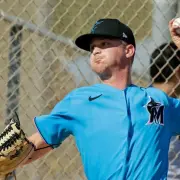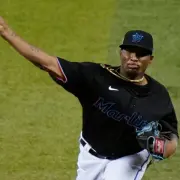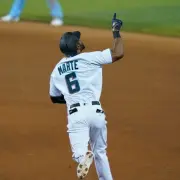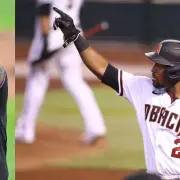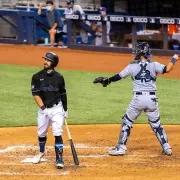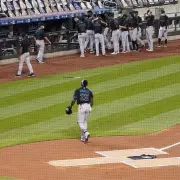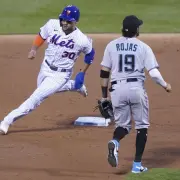The 5-day, 7-game series between the Miami Marlins and Philadelphia Phillies stands as the most important series in recent Marlins history. Meaningful baseball in September is not something Marlins Park has witnessed lately. After a rousing walk-off win on Thursday, the Marlins split Friday’s doubleheader with the Phillies, taking Game 2 5-3 after a 11-0 Game 1 loss.
Here’s a look at five takeaways from the Marlins doubleheader split with the Phillies.
Dontrelle Willis in on Trevor Rogers
The Marlins have a bevy of young arms at their disposal. And while most of the headline these days have been reserved for Sixto Sanchez, Trevor Rogers has also impressed. Entering Friday’s doubleheader, Rogers posted a 3.00 ERA with 21 strikeouts over his first three starts at the Major League level.
Rogers, a former first-round pick by the Marlins, outdueled two-time Cy Young award winner Jacob deGrom. He then notched a career-high 10 strikeouts in his last outing against Tampa Bay. Perhaps most impressive is Rogers accomplishments come without a single start above Double-A prior to 2020.
Rogers piled up five strikeouts over the first two innings on Friday. Unfortunately, though, the potent Phillies lineup figured him out in the third and fourth innings, putting up nine runs (eight earned) and chasing him from the game. Rogers exited with 26 strikeouts over his first four career starts with the Marlins, matching the franchise record held by Dontrelle Willis.
During the game, Willis voiced his support for Rogers on Twitter.
“[Rogers is] a strike thrower with great life but teams can use that to be aggressive (which the Phillies did the second time around) and they swing at everything cause they know it’s going to be in the zone,” Willis said on Twitter. “I was effectively wild so they couldn’t do that to me.”
Rogers will have to make adjustments, like moving the hitters’ feet, which Willis mentioned, if he wants to continue his early-season successes. After Friday’s performance, Rogers’ ERA jumped from 3.00 to 6.50.
Run Differential Doesn’t Mean Much
Entering Saturday’s game, the Marlins team run differential sits at minus-28. That’s the fourth-worst run differential in the National League, but Miami currently sports the sixth-best record in the NL and holds the 7-seed for the playoffs.
Going into their final game in Atlanta earlier this week, the Marlins had an even run differential. What followed over the last four games pushed the run differential to negative-28.
That said, Miami is 2-2 in that span, despite being outscored 45-21.
Wednesday’s historic loss tilted the differential dramatically to the negative. Remove that contest, the Marlins would be minus-8 for the season. Take Friday’s 11-0 game off the ledger and Miami’s plus-3. And that’s just two of the team’s 41 games this season. Even eliminating the Marlins two most lopsided wins of the season (8-0, 8-2) would only move the differential to minus-8.
There’s only one non-playoff team in the NL that sports a better run differential figure at present (Mets, plus-9).
Run differential is often used when judging the likelihood of a team’s sustained success in a season. But with a 60-game sprint, the sample size may be too small. The last time that the team with the best run differential won the World Series was in 2016 (Cubs, plus-252).
Perhaps the most telling part of this might be the fact that Wednesday’s game in Atlanta should not have been such a historic blowout. A seemingly blown call by the umpires in the second inning turned what would’ve been a 2-1 Marlins lead heading into the third into a 11-2 deficit. After that call, and several other borderline ball-and-strike calls in favor of the Braves, the game got out of hand.
What’s more, the Marlins have been better than average in one-run games this season (8-7), after a terrible 2019 (16-28). Miami’s average margin of victory is 2.71, while it’s average margin of defeat is nearly double that at 4.25.
Brinson Breaking Out During Marlins, Phillies Doubleheader
The emergence of Lewis Brinson over the last few weeks has come as a surprise to some, but not to the 26-year-old outfielder.
“It’s not a fluke that I’m here and living out my dream,” Brinson said. “A lot of blood, sweat and tears over the past couple of years. This offseason has been big for me, mentally and physically, being able to trust myself and know that I’m here for a reason.”
Brinson’s third inning home run sparked the Marlins offense in Game 2 of the doubleheader.
“That was big,” Brinson said postgame via Zoom. “Tied the game up against a good lineup. Got momentum on our side a little bit. Obviously after that, we took off a little bit.”
In his last 15 games, Brinson has made strides at the plate. He’s hitting .313 over that stretch with a .989 OPS. In those games, he scored six runs, drove in five and connected on three homers.
“He’s coming along,” Marlins manager Don Mattingly said. “We’ll keep going with him. He’s getting better. We’ll mix and match him a lot of different ways.”
There’s a Competition Brewing at Second Base
The return of Isan Díaz to the lineup this weekend is a welcome one, too. Considered the Marlins second baseman of the future, Diaz opted out for the season in the wake of the COVID-19 outbreak in July. However, after sitting out nearly two months, Diaz opted back in and has been welcomed with open arms.
Playing in his first games since July, Diaz’s RBI single in the fourth inning of Game 2 of the doubleheader put the Marlins up for good.
Prior to the game, Diaz said he’s “very excited to be here again.” He talked about how his decision to opt out was tough and personal. He went on to say he’s appreciative of both the organization and his teammates for welcoming him back.
His return comes after Jon Berti was placed on the 10-day IL. Jazz Chisholm has manned most of the games at second since.
Diaz called Chisholm “a stud” and said he’s “doing a phenomenal job” at second. Diaz revealed he took grounders at third base in Jupiter, something also seen at Marlins park prior to Friday’s games, and claimed he’s ready to play anywhere he’s needed.
Chisholm has manned both second base and shortstop this season. He’s hitting only .160, but in his last two starts, Chisholm has made strides at the plate. He’s 3-for-8 with a triple, a homer, two RBI and a walk in those most recent starts.
In his return, Diaz went 2-for-5 over the doubleheader, driving in one run.
“It’s a good feeling to come back into the clubhouse and see everyone, and see how focused everyone is,” Díaz said postgame. “It’s exciting. I’m ready to go, and I’m happy to be back.”
Is Yimi the New Closer?
Prior to the Marlins doubleheader with the Phillies on Friday, Yimi Garcia said it doesn’t matter to him when or where he pitches.
“I don’t believe in roles,” Garcia said pregame. “I’m ready to pitch from the first inning. I’m available for whatever Donnie needs me and to just get outs.”
Garcia posted a huge shutdown inning during Thursday night’s walkoff win, and on Friday, with Game 2 on the line, Mattingly turned to him rather than the team’s closer, Brandon Kintzler.
Kintzler wound up pitching in the sixth instead of closing. He started the season 9-for-9 in save opportunities but has blown the last two. That, coupled with a fingernail issue that he was having, which Mattingly revealed postgame, may have led to the backend change.
Prior to last night’s save, Garcia’s only other save in his career came with the Dodgers in 2015. His manager then? Don Mattingly.
Garcia surrendered his first run of the season, but shutdown the Phillies to record the save. He’s tallied 12 strikeouts with a 0.93 WHIP this season over 9.2 innings pitched. He certainly has the stuff to be a full-time closer for the Fish.
